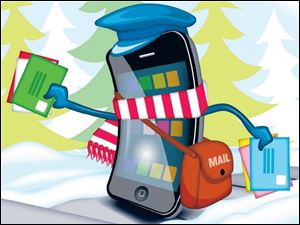
Holiday cards 2011: Traditional correspondence goes paperless with apps
12/3/2011
Does the idea of buying holiday cards, gathering the mailing addresses for friends and family, writing personal notes by hand, buying stamps, addressing envelopes and carting them to the post office just make you hate the holidays?
You're not alone.
More people are skipping paper holiday cards -- or at least the part where you mail them yourself -- in favor of cell phone apps that create cards and send them by text message, email, or snail mail.
Though Web sites like Shutterfly and Paperless Post have already simplified the process by letting people upload photos and order or send cards online, the new apps make it even faster by doing away with the need to transfer a photo from your phone to the computer and write notes and addresses by hand.
Before you disavow the tradition altogether, here are some apps that can bring back the joy of sending holiday cards.
Red Stamp
This greeting card company has been around since 2005 with a Web site to create and order old-fashioned print cards. But this fall, Erin Newkirk, its co-founder and chief executive, closed that business to concentrate on Red Stamp's app for iPhone, iPad, and iPod Touch to send cards virtually.
"'Last year was a huge tipping point in terms of people sending things electronically and by mobile," Ms. Newkirk said. "A lot of our clients didn't have snail mail addresses anymore and wanted to send texts and emails and feel good about it."
The U.S. Postal Service numbers back that up. This holiday season, the post office expects to deliver 2.7 billion letters and process 801 million pieces of mail on Dec. 20, the busiest mailing day of the year. That is down from 3.4 billion holiday letters and 960 million pieces of mail on the busiest day in 2008.
It is intuitive to use. Choose a card; snap a photo or choose one from your phone's library, Facebook or Instagram; customize the color and text; and choose recipients from your phone's address book. The cards can be sent by email, text message, Facebook, or Twitter; texting is particularly popular.
And for those who cannot let go of paper cards -- or who need to send one to Great-Aunt Ethel who doesn't have a cell phone or computer -- Red Stamp also will print and mail postcards. The app, most of the designs and digital delivery are free; postcards start at $1.99, including postage.
Sincerely Ink
Matt Brezina, co-founder and chief executive of Sincerely, a startup, believes it is not just Great-Aunt Ethel who wants printed cards. He introduced an app, Postagram, to turn photos stuck on Instagram, Facebook, and cellphones into printed postcards.
The company's newest app, Sincerely Ink, applies that idea to holiday cards. The designs are fairly traditional (think snowflakes and Christmas trees), and when the season ends, the app will be updated with cards for coming holidays.
''I think physical is and always will be meaningful," Mr. Brezina said. "It's always going to be a less noisy channel to reach people than an email or writing on someone's Facebook wall, and nothing replaces that feeling when you get something in the mail from somebody."
As traditional as that sounds, a Sincerely card is a far cry from the Christmas cards that Hallmark started printing in 1915. Like Red Stamp, the app lets you customize cards with photos and messages and choose recipients on your phone. In three to seven days, within the United States, recipients get heavyweight postcards in the mail.
The app is free and cards range from $1.69 for bulk orders to $2.99 for international deliveries, including postage. It is available on Android, iPhone, and iPad.
The app will come in handy when you receive a holiday card from your boss and realize you didn't send her one, Mr. Brezina said.
"People will use this for last-minute cards," he said. "You can do it on your iPad when you're sitting on your couch reading your Christmas cards."
Cartolina
Cartolina sells high-end paper cards wholesale, but last year, when it introduced its iPhone and iPod Touch app, the company discovered that people also wanted to send cards by text message and email.
Even the Emily Post Institute, the champion of traditional etiquette, has deemed it acceptable to email holiday greetings instead of mailing them, saying that electronic cards are "definitely greener and less expensive."
Cartolina's digital cards are nostalgic, with vintage images of yellowed paper and postage stamps.
"The least digital ones are the ones that are most popular," said Fiona Richards, Cartolina's founder and designer. "The idea of combining that nostalgia with modern high technology really appeals to people."
This year, Cartolina will add holiday designs to the app, which costs $1.99. But card writers must be brief, because they are limited to fewer than 80 characters for their messages.
"For some people, you don't actually want to write a big, long story," Ms. Richards said. "You want to say, 'Hey, happy holidays, remember me?' "
For the more verbose -- or more old-fashioned -- the company joined with Sincerely to introduce a second app, Cartolina Postale, for creating and sending postcards. People can write longer messages and upload photos. Cards cost $1.99, though the app is free.
Apple Cards
For techies who still love stationery, Apple has gone a step further than the other postcard companies by introducing an iPhone and iPod Touch app, Cards, that lets people create artsy letterpress cards that Apple mails in heavy cotton paper envelopes.
In typical Apple fashion, the cards are elegantly designed and addressed in cursive. Users choose from 21 templates, add a photo, write a message and choose addresses from their phones' address books. For $2.99 in the United States, Apple mails the card and sends a notification to the sender's phone when the card is scheduled to arrive.